British Forces at War: As Witnessed by an American
QUOTE
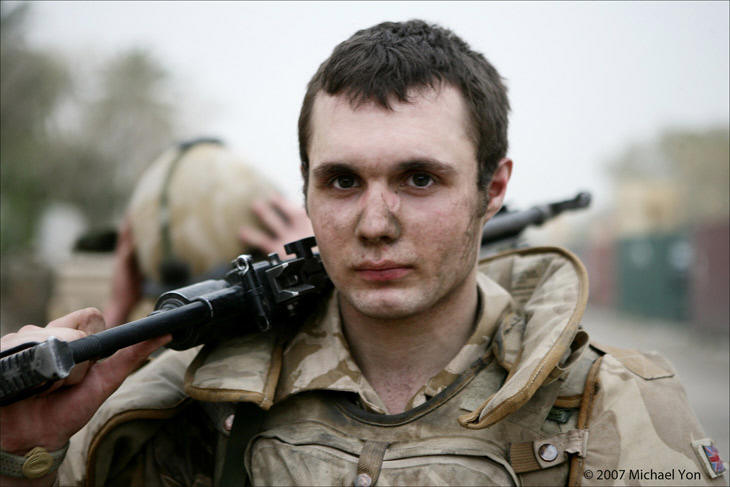
After the Battle: 'Squaddie' from 5 Platoon, 2nd Battalion, 'The
Rifles' Battle Group.
[ The lad looks knackered but then he is -
Editor ]
Basra, Iraq
The explosions from enemy rockets and mortar fire have been constant
companions for the small contingent of Coalition forces based at the
former Basra Palace, on the banks of Shatt al Arab River. In the past
five months, more than a thousand bombs have been fired at this small
base, all while these British combat troops, Romanian soldiers and a
small contingent of Americans continue their attempts to stabilize Iraq.
The nearby US Regional Embassy office also is frequently targeted.
A dramatic surge in IDF attacks (indirect fire: rockets and mortars) began here in September 2006, subsequent an increase in British troops. Locals cite Iranian influence behind the attacks, while British officers say this is the most IDF’d base in Iraq. The dozens of bombs that exploded on the base in the first five days of my embed with a British infantry platoon punctuated those claims.
The building where many British forces live is frequently hit. Recently a rocket slammed into the living quarters, creating a massive gape and much wreckage, while severely wounding one soldier from 5 Platoon. Just this week, a mortar bomb severely damaged a British armored vehicle parked outside, and another bomb explosively pruned a treetop, fragging the building where soldiers live, and leaving ears ringing. A 5 Platoon soldier videotaped the impact as it happened. Amazingly, despite the frequency of the IDF attacks, a combination of force protection measures and sheer luck have prevented the death of any British soldier, though combat forces have been seriously wounded from them. The risk of spending an hour outside the building might be equivalent to smoking a thousand cartons of unfiltered cigarettes. And Crossfit exercise might not help: the old gym was blasted a few days ago.
Earlier this week, when Moqtada al Sadr issued a call to violence against Coalition forces, multiple IDF strikes were launched against this base. Militias based in the al Quibla district of Basra, a notorious haven for Shia “JAM” militias who are loyal to or influenced by al Sadr, were believed responsible. Many of their shots miss the base, landing in civilian populations. According to the British commanders, JAM members will attack local journalists who report these mistakes.
Before al Sadr issued his provocation, the British Army was planning
aggressive offensive actions against terrorists and militia members, and
allowed this writer to join 5 Platoon, 2nd Battalion, “The Rifles”
Battle Group for six days of missions. Those missions included Operation Arezzo, named for the Tuscan city that was the site of famous battles in
the 14th century, and of an important victory for British troops in July
1944 as they drove the Axis forces north and out of Italy for good.
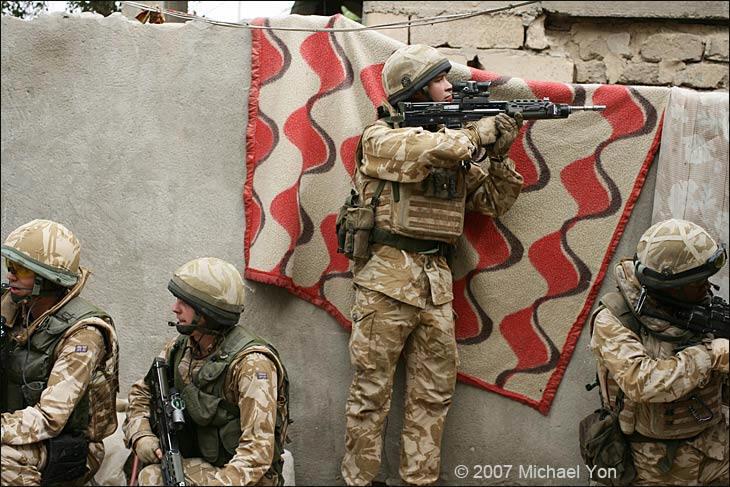
Surrounded by JAM: British Forces just before the shootout
Operation Arezzo
Lieutenant Colonel Justin Maciejewski MBE, the Battle Group
Operations Commander (equivalent to an American Battalion Commander),
allowed this writer unprecedented access to the planning details of
Operation Arezzo, part of three simultaneous strike and arrest
operations in the al Quibla district of Basra, designed in part to bait
the enemy into attacking British forces.
In all, 13 platoons would partake, and I’d accompany 5 Platoon. LTC Maciejewski further permitted me to record both video and still camera images during the operation, and to get as close to the combat as I dare. 5 Platoon has seen a lot of fighting in recent months, and had already taken me on several minor missions. For Operation Arezzo, they adopted me as one of their own.
The plan for Operation Arezzo was cleverly contrived. While Americans count on helicopter support for deliberate high-intensity combat here, the Brits were going into extremely hostile terrain, outnumbered, without helicopter support, relying instead upon timing, terrain, maneuverability, firepower, and sheer audacity.
In combat, luck can be a decisive factor, but Murphy’s Law remains in effect. For Operation Arezzo, the risks of something going catastrophically wrong were apparent at the outset. The soldiers in 5 Platoon had never conducted such an audacious operation—in broad daylight—but LTC Maciejewski intended to show the enemy that even in their strongest bastion, outnumbered British forces could strike into their heart and inflict heavy losses.
Shortly before the mission, as soldiers from 5 Platoon disassembled their weapons for cleaning (again), performed functions checks, the tone of the music coming out of their speakers changed. As with American combat forces, before embarking on a deliberate fight, the music became more rousing and to the bone. For Operation Arezzo, the pre-battle tune was Gimme Shelter, by the Rolling Stones:
War, Children, it’s just a shot away
It’s just a shot away
War, Children, it’s just a shot away
It’s just a shot away
With all the emphasis on timing, 5 Platoon and others (including me) conducted rehearsals just hours before the strike yesterday. Getting to the al Quibla district in one piece was far from certain as we loaded into vehicles and rumbled out into JAM country. Some IEDs (bombs) buried in roads here are so large they would completely destroy the Bulldog tracked vehicle in which we were riding. Just last week a formidable Challenger tank was destroyed by an explosion that also seriously injured the driver. Days before, four British soldiers and their Iraqi interpreter had been killed at the same place when a similar bomb detonated....................
The unilateral British operation began in mid-afternoon on 10 April, kicked off with rapid ground assaults on half a dozen target houses in the district, in an attempt to kill or capture key local militia leaders, including known terrorists such as “The Turban,” who local British forces call “The Turbinator.” The soldiers of 5 Platoon were combat proven after five months of fighting. Last week, they were engaged in a sharp firefight. One soldier captured the action with videocam on his helmet as six enemy were killed in the street fighting, including one enemy who suffered a direct hit from a 5 Platoon grenade launcher. There were no friendly casualties.
Now 5 Platoon was leading a key part of Operation Arezzo, their only
effective close air support were the British snipers on rooftops. We
approached the first target, and the Squaddies rushed out the back of
the Bulldog with me in tow, crashing through gates and tossing flashbang
grenades into doorways before bursting into houses while I made video of
the strike.
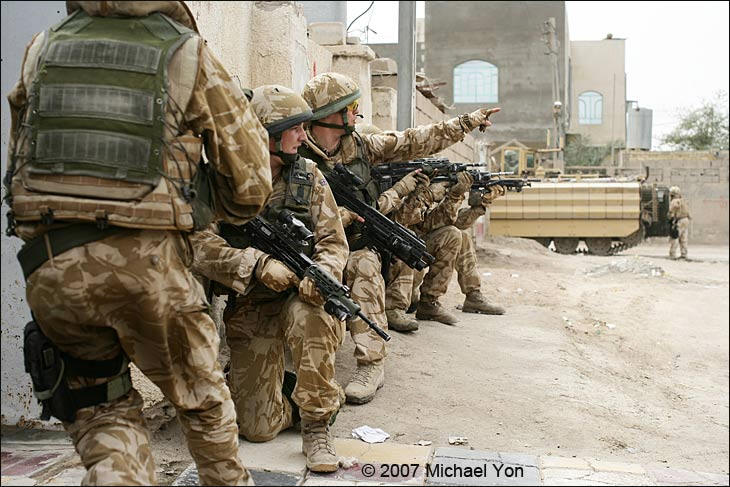
Surrounded by enemy forces, men appear on a roof. A British sniper can
be seen on the roof in the background. Unfortunately, the primary
(“alpha”) targets were not home and escaped death or capture. Nearby,
at about the same time, an Iraqi policeman was murdered.
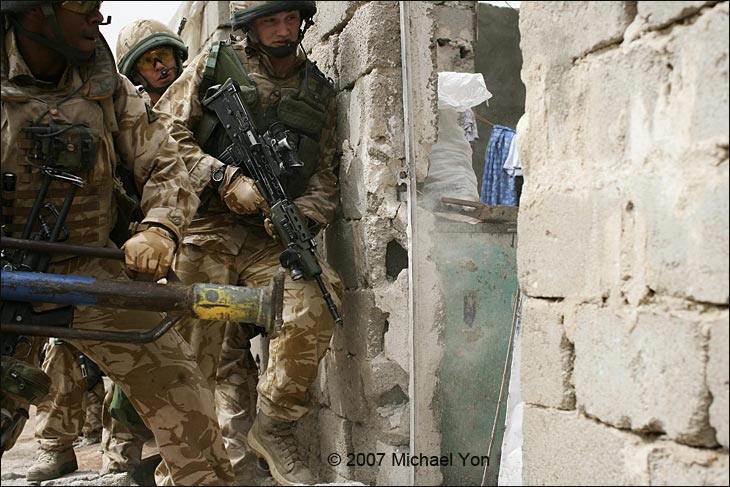
5 Platoon on second entry.
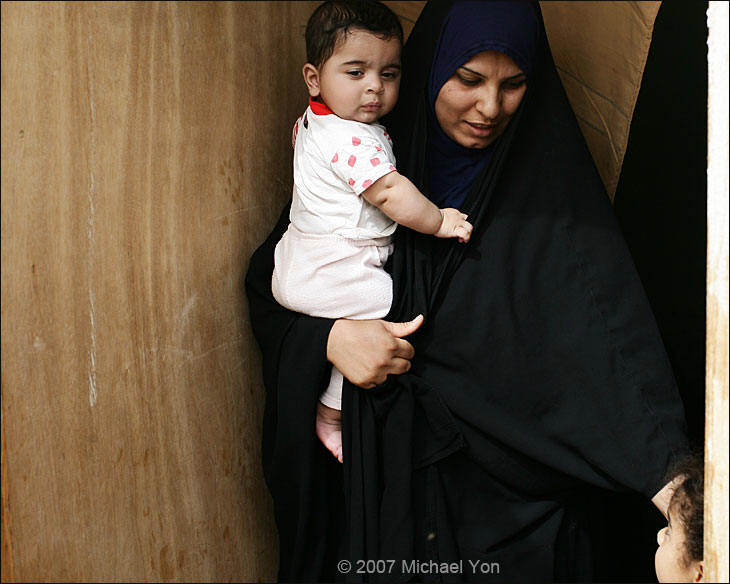
During the third entry, the terrorists were not home, but a woman and
two small children were obviously present. 5 Platoon did not throw flashbangs, and their touch was so light that the small children did
not cry.
But that light touch was reserved for women and children only, as
“The Rifles” would soon demonstrate. With the raids on house targets
completed, a new phase of the plan unfolded and the drama really began.

Almost as if on cue, small-arms fire begins.
During planning, British commanders, including Major Quentin Naylor, had briefed that JAM likely would try to lure us into ambush in a certain area. Now, eerily according to plan, sporadic small arms began from the very direction British commanders had anticipated. If 5 Platoon had moved aggressively in that direction, casualties from our side might be severe, but instead, British forces in armored vehicles moved to other pre-planned areas, hoping to draw the enemy out of hiding and into tactical blunders. The enemy answered the challenge with great enthusiasm, and blundered.
They opened on us with massive small-arms fire from many directions, and RPGs. One RPG slammed into a British vehicle and exploded in the slot armor, but the vehicle took the hit, and the men inside continued to fight. The enemy pounded at one of the platoons with at least one large machine gun, possibly a 12.7 mm, which can blow a man in half and easily defeat British or American armor. But soldiers in that platoon responded with blistering fire, and silenced the gun.
The ensuing firefights were vigorous. As more enemy joined and the
battle progressed, British elements maneuvered and fired, making
adjustments to the plan to mold the fight. With no helicopters above to
help develop ground awareness or to help shape the combat by engaging
targets, British commanders directed their elements by map and
ground-feel. Having no helicopters also left rooftops open to the enemy,
adding another dimension to the combat. In addition to small arms,
British soldiers used 7.62mm machineguns, grenades, and 30mm guns with
deadly focus. As soldiers ran out of ammunition, they dropped back to
reload, while other soldiers kept up the aimed shots.

Reloading during one of the firefights.
The enemy was at times on both sides of us firing from many positions, on the ground and on rooftops. 5 Platoon and others continued answering heavy fire with accurate return fire. I saw a soldier fire his 40mm grenade launcher several times, arching explosive rounds into enemy positions. A British sniper fired four bullets. One 7.62 mm bullet struck an armed man on a rooftop in the chest. Another bullet stopped a gunman who was firing from a car.
Bullets popped into the walls of the vehicles. British planners had anticipated that JAM would by now have placed large IEDs on our egress routes, and the commanders’ plan to defeat this threat so far was working. At least one IED was in fact placed to get us, but exploded at the wrong time and missed a Bulldog.
As the firing began to wane, the day’s heat began to fade along with it. Dust wafted thick on the cooling air. The soldiers were still sweating when a light rain began to fall. Iraqi dust polluted the pure rain as it fell, forming mud drops that splattered onto man and machine.
In an operation that lasted over four hours, British forces killed
26-27 enemy and sustained no casualties. 5 Platoon fired more than 4,000
bullets before their guns began to cool, and about 15 of the enemy kills
were accredited to 5 Platoon. Another platoon captured two enemy
fighters, including one Iraqi policeman who might have been heeding al
Sadr’s call for Iraqi Police and Army forces to turn on their Coalition
partners.
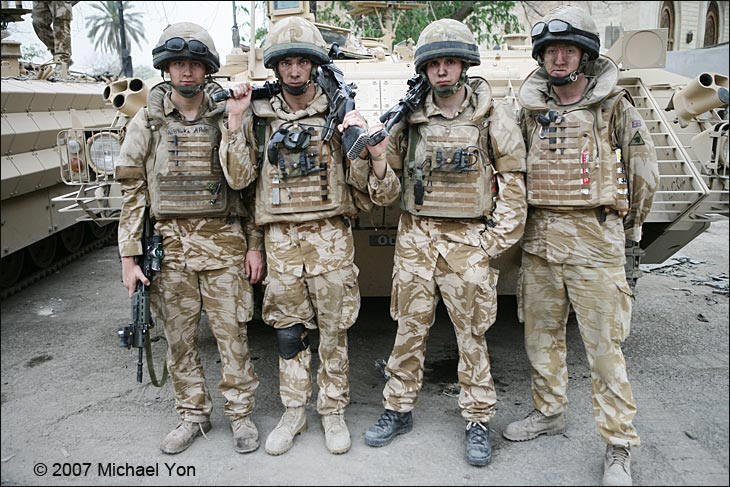
Members of 5 Platoon after the battle.
“Smoking Kills”
Later that evening, back on base, “squaddies” were outside the
converted palace where we sleep, grabbing quick smokes. “Smoking kills”
is the common joke. (British soldiers, like their American kin, are
quick with dry combat humor.) But with all the IDF attacks, soldiers
here truly are taking extreme risks to smoke outside. The palace had
just been hit yesterday, and today more rain fell on its fractured
façade. Sadr had just called for his militias to attack the Coalition,
and “The Rifles” had just killed a couple dozen enemy fighters in JAM
country, which was within easy rocket range of the base.
Rifleman Lee Hulbert, wearing his helmet and body armor, was smoking with his friends when Murphy’s Law kicked in. There was no rocket attack, no lightning strike. About 15 meters (about 50 feet) above Lee’s head, three heavy pieces of marble, each weighing perhaps 10 kg (more than 20 lbs), dislodged from the palace, and hurtled toward Lee Hulbert. One piece struck the back of his helmet, crashed off his body armor, and he fell quiet to the ground. Hulbert had fought well throughout his tour in Iraq, only to be felled by a piece of marble. He’s been med-evac’d [ Casevace'd ] and is said to be in good condition.
The British are planning future operations. These soldiers are so
good that I have requested from British commanders to be allowed to stay
longer.
UNQUOTE
The men did not
frighten the little ones; a major plus.
http://www.mymodernmet.com/profiles/blogs/christmas-photos-from-around

Christmas only comes once a year.